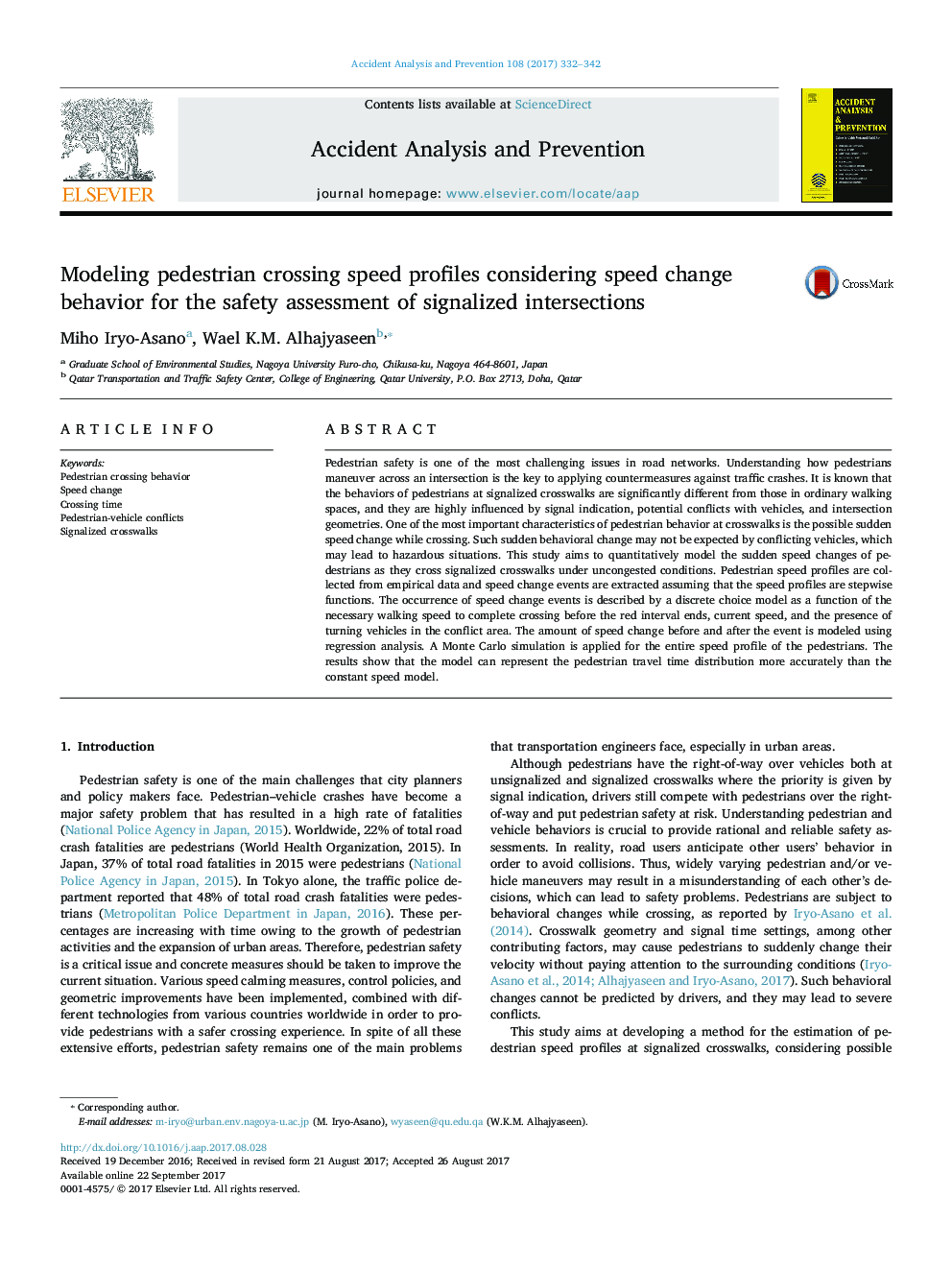| کد مقاله | کد نشریه | سال انتشار | مقاله انگلیسی | نسخه تمام متن |
|---|---|---|---|---|
| 4978535 | 1452891 | 2017 | 11 صفحه PDF | دانلود رایگان |
عنوان انگلیسی مقاله ISI
Modeling pedestrian crossing speed profiles considering speed change behavior for the safety assessment of signalized intersections
ترجمه فارسی عنوان
مدل سازی پروفیل های سرعت عبور پیاده رو با توجه به تغییر سرعت تغییر برای ارزیابی ایمنی تقاطع های سیگنال شده
دانلود مقاله + سفارش ترجمه
دانلود مقاله ISI انگلیسی
رایگان برای ایرانیان
کلمات کلیدی
رفتار گذر عابر پیاده، تغییر سرعت، عبور از زمان، مناقشات خودروی عابر پیاده، پیاده روی های سیگنال یافته،
ترجمه چکیده
ایمنی پیاده روی یکی از مسائل چالش برانگیز در شبکه های جاده ای است. درک اینکه چگونه پیاده ها در سراسر تقاطع مانور می دهند، کلید اعمال مقابله با ترافیک است. شناخته شده است که رفتار پیاده ها در تقاطع های سیگنال نشان داده شده به طور قابل توجهی متفاوت از فضاهای پیاده روی معمول است و به شدت تحت تأثیر نشانه های سیگنال، اختلافات بالقوه با وسایل نقلیه و هندسه های تقاطع قرار دارند. یکی از مهمترین ویژگی های رفتار عابر پیاده در تقاطع ها تغییر سرعت ناگهانی ممکن است در هنگام عبور از آن باشد. چنین تغییری ناگهانی رفتاری ممکن است ناشی از وسایل نقلیه متضاد نباشد، که ممکن است به شرایط خطرناک منتهی شود. این مطالعه با هدف تعدادی تغییرات سریع ناگهانی عابران پیاده را به صورت چندمنظوره انجام می دهد، زیرا آنها عبور می کنند. پروفیل سرعت پیاده رو از داده های تجربی جمع آوری شده و رویدادهای تغییر سرعت استخراج می شوند، فرض می شود که پروفیل های سرعت عملکردهای مرحله ای هستند. وقوع رویدادهای تغییر سرعت با یک مدل انتخاب گسسته به عنوان تابع از سرعت پیاده روی لازم برای تکمیل عبور قبل از پایان فاصله قرمز، سرعت جاری و حضور وسایل نقلیه چرخشی در منطقه جنگ تعریف شده است. مقدار تغییر سرعت قبل و بعد از رویداد با استفاده از تجزیه و تحلیل رگرسیون مدل سازی می شود. یک شبیه سازی مونت کارلو برای نمای کلی سرعت عابر پیاده اعمال می شود. نتایج نشان می دهد که مدل می تواند توزیع زمان سفر پیاده روی را دقیق تر از مدل ثابت ثابت نماید.
موضوعات مرتبط
مهندسی و علوم پایه
مهندسی شیمی
بهداشت و امنیت شیمی
چکیده انگلیسی
Pedestrian safety is one of the most challenging issues in road networks. Understanding how pedestrians maneuver across an intersection is the key to applying countermeasures against traffic crashes. It is known that the behaviors of pedestrians at signalized crosswalks are significantly different from those in ordinary walking spaces, and they are highly influenced by signal indication, potential conflicts with vehicles, and intersection geometries. One of the most important characteristics of pedestrian behavior at crosswalks is the possible sudden speed change while crossing. Such sudden behavioral change may not be expected by conflicting vehicles, which may lead to hazardous situations. This study aims to quantitatively model the sudden speed changes of pedestrians as they cross signalized crosswalks under uncongested conditions. Pedestrian speed profiles are collected from empirical data and speed change events are extracted assuming that the speed profiles are stepwise functions. The occurrence of speed change events is described by a discrete choice model as a function of the necessary walking speed to complete crossing before the red interval ends, current speed, and the presence of turning vehicles in the conflict area. The amount of speed change before and after the event is modeled using regression analysis. A Monte Carlo simulation is applied for the entire speed profile of the pedestrians. The results show that the model can represent the pedestrian travel time distribution more accurately than the constant speed model.
ناشر
Database: Elsevier - ScienceDirect (ساینس دایرکت)
Journal: Accident Analysis & Prevention - Volume 108, November 2017, Pages 332-342
Journal: Accident Analysis & Prevention - Volume 108, November 2017, Pages 332-342
نویسندگان
Miho Iryo-Asano, Wael K.M. Alhajyaseen,
